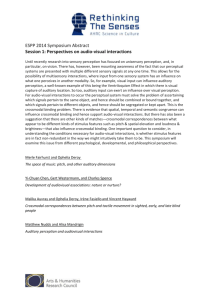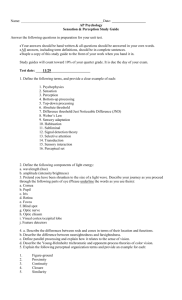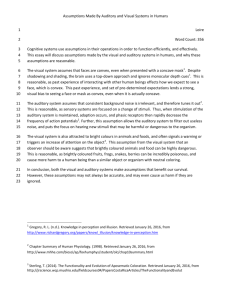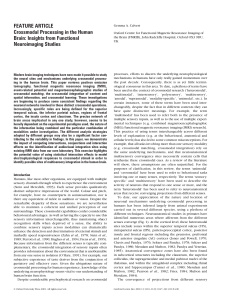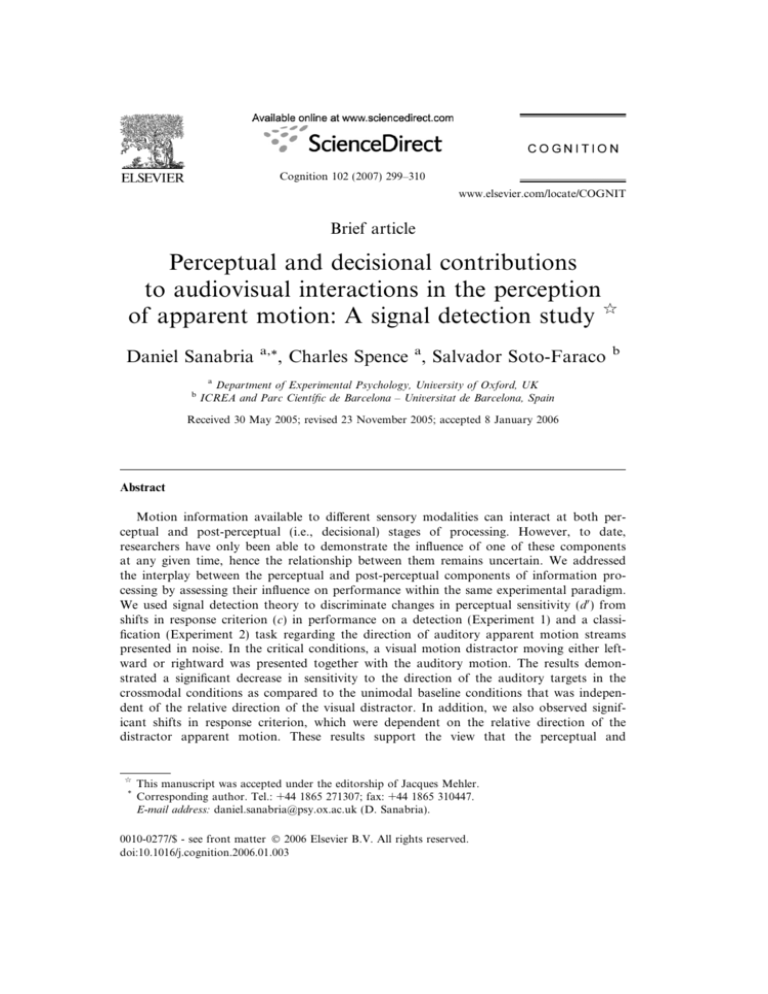
Cognition 102 (2007) 299–310
www.elsevier.com/locate/COGNIT
Brief article
Perceptual and decisional contributions
to audiovisual interactions in the perception
of apparent motion: A signal detection study q
Daniel Sanabria
a,*
, Charles Spence a, Salvador Soto-Faraco
b
a
b
Department of Experimental Psychology, University of Oxford, UK
ICREA and Parc Cientı́fic de Barcelona – Universitat de Barcelona, Spain
Received 30 May 2005; revised 23 November 2005; accepted 8 January 2006
Abstract
Motion information available to different sensory modalities can interact at both perceptual and post-perceptual (i.e., decisional) stages of processing. However, to date,
researchers have only been able to demonstrate the influence of one of these components
at any given time, hence the relationship between them remains uncertain. We addressed
the interplay between the perceptual and post-perceptual components of information processing by assessing their influence on performance within the same experimental paradigm.
We used signal detection theory to discriminate changes in perceptual sensitivity (d 0 ) from
shifts in response criterion (c) in performance on a detection (Experiment 1) and a classification (Experiment 2) task regarding the direction of auditory apparent motion streams
presented in noise. In the critical conditions, a visual motion distractor moving either leftward or rightward was presented together with the auditory motion. The results demonstrated a significant decrease in sensitivity to the direction of the auditory targets in the
crossmodal conditions as compared to the unimodal baseline conditions that was independent of the relative direction of the visual distractor. In addition, we also observed significant shifts in response criterion, which were dependent on the relative direction of the
distractor apparent motion. These results support the view that the perceptual and
q
*
This manuscript was accepted under the editorship of Jacques Mehler.
Corresponding author. Tel.: +44 1865 271307; fax: +44 1865 310447.
E-mail address: daniel.sanabria@psy.ox.ac.uk (D. Sanabria).
0010-0277/$ - see front matter Ó 2006 Elsevier B.V. All rights reserved.
doi:10.1016/j.cognition.2006.01.003
300
D. Sanabria et al. / Cognition 102 (2007) 299–310
decisional components involved in audiovisual interactions in motion processing can coexist but are largely independent of one another.
Ó 2006 Elsevier B.V. All rights reserved.
Keywords: Crossmodal interactions; Motion perception; Apparent motion; Audition; Vision
1. Introduction
Recent research has revealed substantial crossmodal links in the processing of
motion information (Soto-Faraco, Kingstone, & Spence, 2003). Multisensory interactions in motion perception have often been addressed using intersensory conflict
situations (Welch & Warren, 1980) where participants judge a particular feature of
motion in one sensory modality (e.g., sound direction) while trying to ignore
motion information presented in another modality (e.g., vision). Given that the
irrelevant distractors can potentially affect perceptual (Soto-Faraco, Spence, &
Kingstone, 2005) as well as decisional (post-perceptual) mechanisms (Wuerger,
Hofbauer, & Meyer, 2003), the level of processing at which these interactions take
place remains somewhat controversial (Bertelson & de Gelder, 2004; Soto-Faraco
et al., 2003).
Dissociating perceptual from post-perceptual processes is critical to many areas of
crossmodal research (Aschersleben, Bachmann, & Musseler, 1999; Bertelson & de
Gelder, 2004; de Gelder & Bertelson, 2003). Perceptual processes affect the combination of multisensory cues prior to response selection/execution, whereas post-perceptual processes influence general response selection and/or execution mechanisms
instead. Several studies addressing audiovisual interactions in motion processing
have reported post-perceptual influences in the absence of any perceptual effects,
supporting the claim that motion cues are processed independently in each sensory
modality at a perceptual level, with any interactions occurring only at decisional
stages (Alais & Burr, 2004; Meyer & Wuerger, 2001; Wuerger et al., 2003). By contrast, other findings support the notion that auditory and visual motion information
can interact at a perceptual level (Kitagawa & Ichihara, 2002; Mateeff, Hohnsbein, &
Noack, 1985; Soto-Faraco et al., 2005; Vroomen & de Gelder, 2003). These latter
studies have used methodologies such as psychophysical staircases (Soto-Faraco
et al., 2005) or adaptation after-effects (Kitagawa & Ichihara, 2002; Vroomen &
de Gelder, 2003), that are designed to minimize potential cognitive and/or response
biases that affect decisional stages of processing. Overall, this pattern of results suggests that both perceptual and post-perceptual influences might play a significant
role in explaining the interactions between auditory and visual motion.
We investigated the relationship between these two components within the same
experimental paradigm by using signal detection theory (SDT; Macmillan & Creelman, 1991). Participants had to detect auditory apparent motion streams moving in
a predefined (target) direction (left or right). In one condition, auditory streams (that
could move in the target or the non-target direction) were combined with visual
D. Sanabria et al. / Cognition 102 (2007) 299–310
301
distractor motion that always moved in the direction of the pre-defined target (target-compatible block). In the other condition, the visual distractors always moved
in the direction opposite to the pre-defined target auditory motion (target-incompatible block). Both conditions were physically equivalent (with directionally congruent
and incongruent audiovisual motion displays being equiprobable), the only difference being that the direction of the visual distractor was either compatible or incompatible with the pre-defined auditory target direction (see Fig. 1). Participants also
performed a unimodal block where they detected the direction of sound streams in
the absence of visual distractors.
If visual motion can capture the perceived direction of auditory motion (SotoFaraco et al., 2005), then we should find considerable lower sensitivity in crossmodal
blocks than in the unimodal baseline. That is, participants should find it more difficult to discern the direction of sounds because of the influence exerted by the visual
distractors, which always move in one direction. Since target-compatible and targetincompatible blocks contain physically equivalent trials, they should be no different
in terms of participants’ sensitivity. Any influence of the visual distractor on participants’ decisions about sound direction should manifest itself as a change in the
response criterion, that would shift as a function of compatibility of the direction
of visual motion.
To ensure that participants in Experiment 1 performed a pure detection task
(as opposed to a discrimination task), we used a go/no-go procedure. In
Experiment 2, we used a two-alternative forced-choice (2AFC) procedure to
assess the influence of the task at hand on participants’ response criterion,
as the processes involved in the decision and response execution have sometimes been shown to differ between these two tasks (Chmiel, 1989; Perea, Rosa,
& Gómez, 2002).
Fig. 1. Example of the type of audiovisual (directionally congruent and incongruent) trials present in the
two crossmodal blocks (target-compatible and target-incompatible). In the example shown here, the
direction of target auditory motion was toward the right. Note that when participants were instructed to
detect leftward auditory motion the auditory and visual streams moved in opposite directions to those
depicted in the figure. AM and VM refer to the direction of auditory and visual motion, respectively.
302
D. Sanabria et al. / Cognition 102 (2007) 299–310
2. Experiment 1
2.1. Methods
2.1.1. Participants
Forty-eight participants (34 women, 19–40 years) took part. All reported normal
hearing and normal or corrected-to-normal vision.
2.1.2. Apparatus and stimuli
Four loudspeakers (10 cm in diameter) positioned at eye-level were used to present the auditory stimuli. The visual stimuli consisted of the illumination of four
orange LEDs (1 cm in diameter), each situated directly above each loudspeaker
(see Fig. 2).
The apparent motion streams consisted of four events (white noise burst 65 dB[A]
for the sounds, and LED flashes for the lights) sequentially presented (50 ms on,
50 ms off) from each of four correlative spatial locations from left-to-right or vice
versa. An auditory mask consisting of four 50 ms white noise bursts (65 dB[A],
50 ms off time) originating from the centre (elicited by simultaneously presenting
sounds to the loudspeakers located on either side) before and after the auditory stimulus was used to lower performance.
2.1.3. Procedure
Participants sat in a dark room and were asked to detect either leftward or rightward
auditory apparent motion by pressing a key on a keyboard, and withholding their
response when the sound moved in the non-target direction (target direction was
manipulated across participants). The sounds moved in the target direction on 50%
of trials and in the opposite direction on the remaining trials. The next trial commenced
1500 ms after response or after 3500 ms on trials where no response was made.
The session began with a practice block in which 12 auditory streams were presented in the absence of visual distractors (this was repeated if performance was
Fig. 2. Illustration of the experimental set-up used in the present study.
D. Sanabria et al. / Cognition 102 (2007) 299–310
303
below 83%). Then a threshold block was run to establish the mask-target-interval
(MTI) at which the participant’s performance without visual distractors fell between
65% and 85% (using the method of limits). The MTI was continually adjusted
according to the performance in the last 10 trials throughout the rest of the experiment. Next, in the baseline block participants completed 60 trials of auditory streams
(50% in the target direction) presented in the absence of visual distractors. Finally,
two crossmodal blocks (order counterbalanced) were run. Each consisted of 60 trials
(50% in the target direction) in which a visual apparent motion stream was presented
in synchrony with the auditory stream, and in a fixed direction. In the ‘‘target-compatible’’ block, the visual distractor direction matched that of the predefined target
auditory motion (if the task was to detect leftward auditory motion, the visual
motion always moved toward the left). In the ‘‘target-incompatible’’ block, the direction of the visual distractor was always opposite to that of the pre-defined target
auditory motion. Note that crossmodal blocks contained 50% audiovisually congruent and 50% audiovisually incongruent trials, regardless of the auditory target direction to which participants were instructed to respond to (see Fig. 1) and the
compatibility of the visual distractor with this target direction.
2.2. Results
Sensitivity (d 0 ) and criterion (c) were assessed in the unimodal baseline, and in
the target-compatible and target-incompatible crossmodal blocks for each participant based on their hit and false-alarm rate. Repeated-measures analyses of variance (ANOVA) revealed no significant differences in either d 0 or c (both Fs < l) as
a function of absolute target direction (left or right), thus the data were pooled
across this variable in subsequent analyses. d 0 was significantly higher in the baseline unimodal block (M = 1.76) than in either crossmodal block (target-compatible,
M = 1.24, |t| (47) = 4.10, p < .001; target-incompatible, M = 1.36, |t| (47) = 2.95,
p = .004). The difference in d 0 between the two crossmodal blocks was not significant, |t| < 1.
For the criterion data, in the baseline condition c was virtually zero (there was no
preference toward responding or not), whereas c was negative in the target-compatible block (M = 0.24, revealing a bias toward responding) and positive in the target-incompatible block (M = 0.22; people tended not to respond). The differences in
c between the baseline block and the two crossmodal blocks, and the difference
between the two crossmodal blocks themselves, were all significant (all ps < .01;
see Fig. 3).
The results of Experiment 1 revealed that visual motion information had a significant influence on the perceived direction of auditory motion (i.e., on the ability of
participants to distinguish a leftward from a rightward moving sound). This decrease
in d 0 was independent of the compatibility effect arising between the direction of tobe-detected auditory target and the direction of the visual distractor. However,
response criterion shifted as a function of the compatibility between target direction
and the distractor direction. This provides a dissociation between the perceptual and
decisional components responsible for audiovisual interactions in motion perception.
304
D. Sanabria et al. / Cognition 102 (2007) 299–310
Fig. 3. (a) Mean d 0 (+SE) as a function of the Experiment (1 or 2) and condition (baseline, targetcompatible, and target-incompatible). (b) Mean c (+SE) as a function of the experiment and condition.
In Experiment 1, we used a go/no-go task to ensure that participants performed a detection task. However, it has been argued that different responserelated processes might be involved in 2AFC discrimination tasks (Perea
et al., 2002), thus potentially affecting the conclusions of our study. In Experiment 2, we used a 2AFC task in which participants responded to both the
target direction (‘‘yes’’ response) and non-target direction (‘‘no’’ response)
auditory streams. Another factor that might have affected the criterion measures in Experiment 1 was the particular auditory masking procedure used.
As the MTI was adjusted continually on the basis of each participant’s performance, it is possible that the difficulty of the task changed within each
experimental block, perhaps eliciting shifts in response criterion and interacting
with the distracting effects induced by the irrelevant visual information. In
Experiment 2, constant white noise was presented instead of the auditory
mask to maintain a constant level of difficulty throughout the experimental
session.
D. Sanabria et al. / Cognition 102 (2007) 299–310
305
3. Experiment 2
3.1. Methods
3.1.1. Participants
Twenty-eight new participants (18 women, 16–32 years) took part. The data from
two participants were removed as they performed at chance levels in the baseline
condition.
3.1.2. Apparatus and stimuli
Participants were instructed to press ‘‘h’’ or ‘‘b’’ on the keyboard whenever the
sound appeared to move in the target or the non-target direction (respectively;
response mapping reversed for half of the participants). The next trial began only
after participants had responded (1500 ms intertrial interval). White noise
(77 dB[A]) was presented continuously from a loudspeaker placed 20 cm behind
the participant to bring performance off ceiling (performance in a pilot study with
this noise level was below 80%).
3.2. Results
d 0 was significantly higher in the baseline block (M = 1.26) than in either the target-compatible, |t| (25) = 2.55, p = .02, or target-incompatible crossmodal blocks,
|t| (25) = 2.32, p = .03 (M = 0.77 and 0.88, respectively), whereas the two crossmodal
blocks did not differ, |t| < 1. Criterion (was close to zero in the unimodal baseline
block (M = 0.02), negative in the target-compatible block (M = 0.33) and positive
in the target-incompatible block M = 0.29). All comparisons reached statistical significance (all ps < .001; see Fig. 3).
We performed a between-experiments analysis with Experiment (1 and 2) and
condition (unimodal, target-compatible, and target-incompatible) as factors. There
was no interaction between condition and experiment in d 0 F (1, 72) < 1, though participants performed worse in Experiment 2 than in Experiment 1 (M = 1.45 and 0.97,
respectively; F (l, 72) = 17.51, p < .0001), indicating that the white noise mask
(Experiment 2) proved more effective than the mask procedure used in Experiment
1. Critically, the main effect of condition, F (2, 72) = 13.91, p < .0001, revealed the
same pattern observed in each of the individual experiments. The analysis of c only
showed a significant main effect of condition, F (2, 72) = 46.33, p < .0001, again supporting the results of each individual experiment.
In Experiment 2, participants performed a 2AFC task regarding the direction of
auditory apparent motion (Soto-Faraco, Lyons, Gazzaniga, Spence, & Kingstone,
2002), allowing us to analyse the data from the crossmodal blocks in terms of the
directional congruency between the two modalities. d 0 was higher for directionally
congruent trials (M = 1.46) than for incongruent ones (M = 0.19; t (25) = 6.39,
p < .001). Participant’s were also more sensitive on congruent trials than in the unimodal baseline (M = 1.26), although this difference was not statistically significant,
t (25) = 1.09, p = .28. These results suggest that the decrement in d 0 reported in the
306
D. Sanabria et al. / Cognition 102 (2007) 299–310
crossmodal blocks was primarily caused by a decrease in participants’ sensitivity
caused by directional incongruence between visual and acoustic cues to motion, supporting our earlier prediction. The results regarding participants’ sensitivity in
Experiments 1 and 2 cannot be solely accounted for by an interference effect due
to the presence of irrelevant visual information (which was present in both the congruent and incongruent trials). On the contrary, it appears that the perceived direction of the auditory apparent motion stream was captured by the direction of the
visual apparent motion stream on incongruent trials, resulting in an overall reduction of perceptual sensitivity.
The results of Experiment 2 reinforce those of Experiment 1 in showing that the
perceptual and post-perceptual influences on audiovisual interactions are independent. Importantly, there were no significant changes in criterion between the two
experiments, suggesting that the same response mechanisms were invoked by participants in the 2AFC and go/no-go tasks used here (Gómez, Perea, & Ratcliff, submitted). Furthermore, Experiment 2 confirmed that the shifts in c were caused by the
direct influence of the visual information and not by the particular masking procedure used in Experiment I1.
4. General discussion
These findings provide the first empirical evidence for the independent co-existence of both perceptual and post-perceptual influences on audiovisual interactions
in motion processing2. Our results confirm the existence of interactions at a perceptual level in the processing of motion information (Soto-Faraco et al., 2005), consistent with previous data obtained using static events (Bertelson & de Gelder, 2004).
Additionally, the reported shifts in c, independent of changes in d 0 , confirmed that
the congruence of visual motion information can also bias decisions about the direction of sounds.
Previous studies of audiovisual interactions in motion perception have arrived at
apparently divergent conclusions regarding the level of processing at which these
interactions occur. A number of studies have suggested that auditory and visual
1
A further control experiment (N = 16) was run with constant white noise (as in Experiment 2) and a
go/no-go task (as in Experiment 1). The results were equivalent to those of Experiments 1 and 2. Namely,
we found significant differences in d 0 between the unimodal baseline block (M = 2.41) and both
crossmodal blocks (M = 1.47; p < .01, for target-compatible; and M = 1.62; p < .01, for targetincompatible), whereas the two crossmodal blocks did not differ (|t| < 1). The difference in c between
the target-compatible and target-incompatible crossmodal blocks was significant (M = 0.10 and 0.63,
respectively, p < .01). There were also significant differences in c between the unimodal baseline block
(M = 0.39) and both crossmodal blocks (ps < .05).
2
It is worth noting that audiovisual interactions in the perception of motion are asymmetrical. While
vision has been shown to exert a considerable influence over the perception of moving auditory stimuli,
visual motion perception is usually little influenced by audition (Soto-Faraco, Spence, & Kingstone, 2004).
Therefore, one might expect that, unless the visual signal is presented at or near threshold (cf. Meyer &
Wuerger, 2001), visual motion processing would not be influenced by distracting auditory information.
D. Sanabria et al. / Cognition 102 (2007) 299–310
307
motion information can interact prior to response selection/execution (Soto-Faraco
et al., 2005), whereas others have argued against the existence of perceptual interactions in the perception of audiovisual motion (Wuerger et al., 2003). The present
study demonstrates the existence of both perceptual and post-perceptual influences
on audiovisual interactions in the perception of motion within the same experimental
protocol. Importantly, these influences were shown to be largely independent of one
another.
Meyer and Wuerger (2001) studied the effect of irrelevant auditory motion
information on visual motion processing, and reported large shifts in response
criterion consistent with the direction of distractors, together with a small decrement in perceptual sensitivity to visual motion in congruent audiovisual displays. This sensitivity shift is an intriguing result, given that it contrasts with
other studies that have demonstrated perceptual enhancement (and not inhibition) for co-localized (and congruent) audiovisual signals (Meyer, Wuerger,
Röhrbein, & Zetzsche, 2005). Indeed, as noted by the authors themselves, it is
unlikely that the changes in the sensitivity index in their study were caused
by interactions taking place at a perceptual level of processing (cf. Soto-Faraco
& Kingstone, 2004).
It seems likely that the decrement in d 0 reported in the crossmodal blocks (as
compared to the unimodal baseline block) of Experiments 1 and 2 reflects the
existence of a perceptual illusion whereby the perceived direction of the auditory
stream was, in many trials, ‘‘captured’’ by the direction of motion of the visual
stream. That is, on trials where the auditory and visual streams moved in opposite directions, observers may have perceived the sounds moving in the direction
of the visual stream, thereby resulting in a reduced ability to distinguish these
incongruent trials from congruent ones (when sounds actually moved in the direction of visual distractors). This interpretation is supported by phenomenological
reports from early studies (Zapparoli & Reatto, 1969) as well as by recent psychophysical data (Soto-Faraco et al., 2005). However, the decrease in d 0 reported
in the crossmodal blocks might also reflect a cost of dividing attention between
the visual and the acoustic information (Bonnel & Hafter, 1998). We do not
favour this interpretation because, using a similar stimulus set-up to that
described here, Soto-Faraco et al. (2002, Experiment 3) failed to observe any decrement in performance when the visual and auditory streams moved in orthogonal
directions (i.e., the mere presence of visual motion information seemed insufficient
in-and-of-itself to influence the perception of auditory motion in the manner
observed here). Moreover, a decrement in d 0 was only found on incongruent
audiovisual trials, while a numerical (albeit not statistically significant) increase
in perceptual sensitivity was found on congruent audiovisual trials, supporting
the ‘capture’ account, rather than the distraction account.
Visual motion information not only affected the perceptual processing of auditory
motion, but also participants’ decisions regarding the direction of the auditory
streams. The fact that the feature to be judged (left–right direction) was the same
as the dimension in which the visual distractors moved introduced potential stimulus-response compatibility effects (Simon, 1990; see Bosbach, Prinz, & Kerzel,
308
D. Sanabria et al. / Cognition 102 (2007) 299–310
2004, 2005, for examples of such effects elicited by moving stimuli). At decisional
stages of information processing, the response code for the direction of motion
would have been primed by the direction of the salient visual distractor stimulus,
accounting for the tendency toward ‘‘yes’’ responses in target-compatible blocks
and toward ‘‘no’’ responses in target-incompatible blocks.
The results reported here go beyond previous research that has investigated multisensory motion processing by demonstrating the independent co-existence of both
perceptual and post-perceptual influences on performance, while at the same time
providing solid evidence regarding the perceptual nature of these crossmodal interactions. Thus, the present results stands in contrast with recent studies claiming that
visual and auditory motion information interact only at decisional stages (Alais &
Burr, 2004; Meyer & Wuerger, 2001; Wuerger et al., 2003). We believe that methodological factors that might have promoted sensory segregation rather than sensory
integration (see Sanabria, Soto-Faraco, Chan, & Spence, 2005, for empirical evidence) may account for the null results reported in these earlier studies. For example,
the use of random dots kinetograms and inter-aural differences for the visual and
auditory stimuli (respectively) in these previous studies means that the auditory
and visual cues to motion were different in number and were not necessarily spatially
co-localised. In contrast, we used discrete visual and auditory stimuli that were both
spatially and temporally matched (Soto-Faraco et al., 2002, 2004), and were of an
equal number (Sanabria et al., 2005; Spence, Sanabria, & Soto-Faraco, in press).
As has been shown for the case of static events (Morein-Zamir, Soto-Faraco, &
Kingstone, 2003; Spence & Driver, 2004; see also Welch, 1999), it would seem likely
that in order to find the most pronounced crossmodal interactions at early levels of
processing, auditory and visual inputs need to be spatiotemporally aligned and
matched in number as far as possible.
Acknowledgements
This study was supported by a Network Grant from the McDonnell-Pew Centre
for Cognitive Neuroscience in Oxford to Salvador Soto-Faraco and Charles Spence.
References
Alais, D., & Burr, D. (2004). No direction-specific bimodal facilitation for audiovisual motion detection.
Cognitive Brain Research, 19, 185–194.
Aschersleben, G., Bachmann, T., & Musseler, J. (Eds.). (1999). Cognitive contributions to the perception of
spatial and temporal events. Amsterdam: Elsevier Science.
Bertelson, P., & de Gelder, B. (2004). The psychology of multimodal perception. In C. Spence & J. Driver
(Eds.), Crossmodal space and crossmodal attention (pp. 141–179). Oxford: Oxford University Press.
Bonnel, A., & Hafter, E. (1998). Divided attention between simultaneous auditory and visual signals.
Perception & Psychophysics, 60, 179–190.
Bosbach, S., Prinz, W., & Kerzel, D. (2004). A Simon effect with stationary moving stimuli. Journal of
Experimental Psychology: Human Perception and Performance, 30, 39–55.
D. Sanabria et al. / Cognition 102 (2007) 299–310
309
Bosbach, S., Prinz, W., & Kerzel, D. (2005). Is direction position? Position and direction-based
correspondence effects in tasks with moving stimuli. Quarterly Journal of Experimental Psychology,
58A, 467–506.
Chmiel, N. (1989). Response effect in the perception of conjunctions of colour and form. Psychological
Research, 51, 117–122.
de Gelder, B., & Bertelson, P. (2003). Multisensory integration, perception, and ecological validity. Trends
in Cognitive Sciences, 7, 460–467.
Gómez, P., Perea, M., & Ratcliff, R. (submitted for publication). A model of the go/no-go lexical decision
task. Journal of Experimental Psychology: General.
Kitagawa, N., & Ichihara, S. (2002). Hearing visual motion in depth. Nature, 416, 172–174.
Macmillan, N. A., & Creelman, C. D. (1991). Detection theory: A user’s guide. Cambridge: Cambridge
University Press.
Mateeff, S., Hohnsbein, J., & Noack, T. (1985). Dynamic visual capture: Apparent auditory motion
induced by a moving visual target. Perception, 14, 721–727.
Meyer, G. F., & Wuerger, S. M. (2001). Cross-modal integration of auditory and visual motion signals.
Neuroreport, 12, 2557–2560.
Meyer, G. F., Wuerger, S. M., Röhrbein, F., & Zetzsche, C. (2005). Low-level integration of auditory and
visual motion signals requires spatial co-localisation. Experimental Brain Research, 166, 538–547.
Morein-Zamir, S., Soto-Faraco, S., & Kingstone, A. (2003). Auditory capture of vision: Examining
temporal ventriloquism. Cognitive Brain Research, 17, 154–163.
Perea, M., Rosa, E., & Gómez, C. (2002). Is the go/no-go lexical decision task an alternative to the yes/no
lexical decision task? Memory & Cognition, 30, 34–45.
Sanabria, D., Soto-Faraco, S., Chan, J., & Spence, C. (2005). Intramodal perceptual grouping modulates
multisensory integration: Evidence from the crossmodal dynamic capture task. Neuroscience Letters,
377, 59–64.
Simon, J. R. (1990). The effects of an irrelevant directional cue on human information processing. In R. W.
Proctor & T. G. Reeve (Eds.), Stimulus-response compatibility (pp. 31–86). Amsterdam: Elsevier Science.
Soto-Faraco, S., & Kingstone, A. (2004). Multisensory integration of dynamic information. In G. A.
Calvert, C. Spence, & B. E. Stein (Eds.), The handbook of multisensory processes (pp. 49–68).
Cambridge, MA: MIT Press.
Soto-Faraco, S., Kingstone, A., & Spence, C. (2003). Multisensory contributions to the perception of
motion. Neuropsychologia, 41, 1847–1862.
Soto-Faraco, S., Lyons, J., Gazzaniga, M., Spence, C., & Kingstone, A. (2002). The ventriloquist in
motion: Illusory capture of dynamic information across sensory modalities. Cognitive Brain Research,
14, 139–146.
Soto-Faraco, S., Spence, C., & Kingstone, A. (2004). Cross-modal dynamic capture: Congruency effects in
the perception of motion across sensory modalities. Journal of Experimental Psychology: Human
Perception and Performance, 30, 330–345.
Soto-Faraco, S., Spence, C., & Kingstone, A. (2005). Assessing automaticity in the audio-visual
integration of motion. Acta Psychologica, 118, 71–92.
Spence, C., & Driver, J. (Eds.). (2004). Crossmodal space and crossmodal attention. Oxford: Oxford
University Press.
Spence, C., Sanabria, D., & Soto-Faraco, S. (in press). Intersensory Gestalten and crossmodal scene
perception. In K. Noguchi (Ed.). The psychology of beauty and Kansei: New horizon of Gestalt
perception (to appear).
Vroomen, J., & de Gelder, B. (2003). Visual motion influences the contingent auditory motion aftereffect.
Psychological Science, 14, 357–361.
Welch, R. B. (1999). Meaning, attention, and the ‘‘unity assumption’’ in the intersensory bias of spatial
and temporal perceptions. In G. Aschersleben, T. Bachmann, & J. Müsseler (Eds.), Cognitive
contributions to the perception of spatial and temporal events (pp. 371–387). Amsterdam: Elsevier
Science.
Welch, R. B., & Warren, D. H. (1980). Immediate perceptual response to intersensory discrepancy.
Psychological Bulletin, 88, 638–667.
310
D. Sanabria et al. / Cognition 102 (2007) 299–310
Wuerger, S. M., Hofbauer, M., & Meyer, G. F. (2003). The integration of auditory and visual motion
signals at threshold. Perception & Psychophysics, 65, 1188–1196.
Zapparoli, G. C., & Reatto, L. L. (1969). The apparent movement between visual and acoustic stimulus
and the problem of intermodal relations. Acta Psychologica, 29, 256–267.


